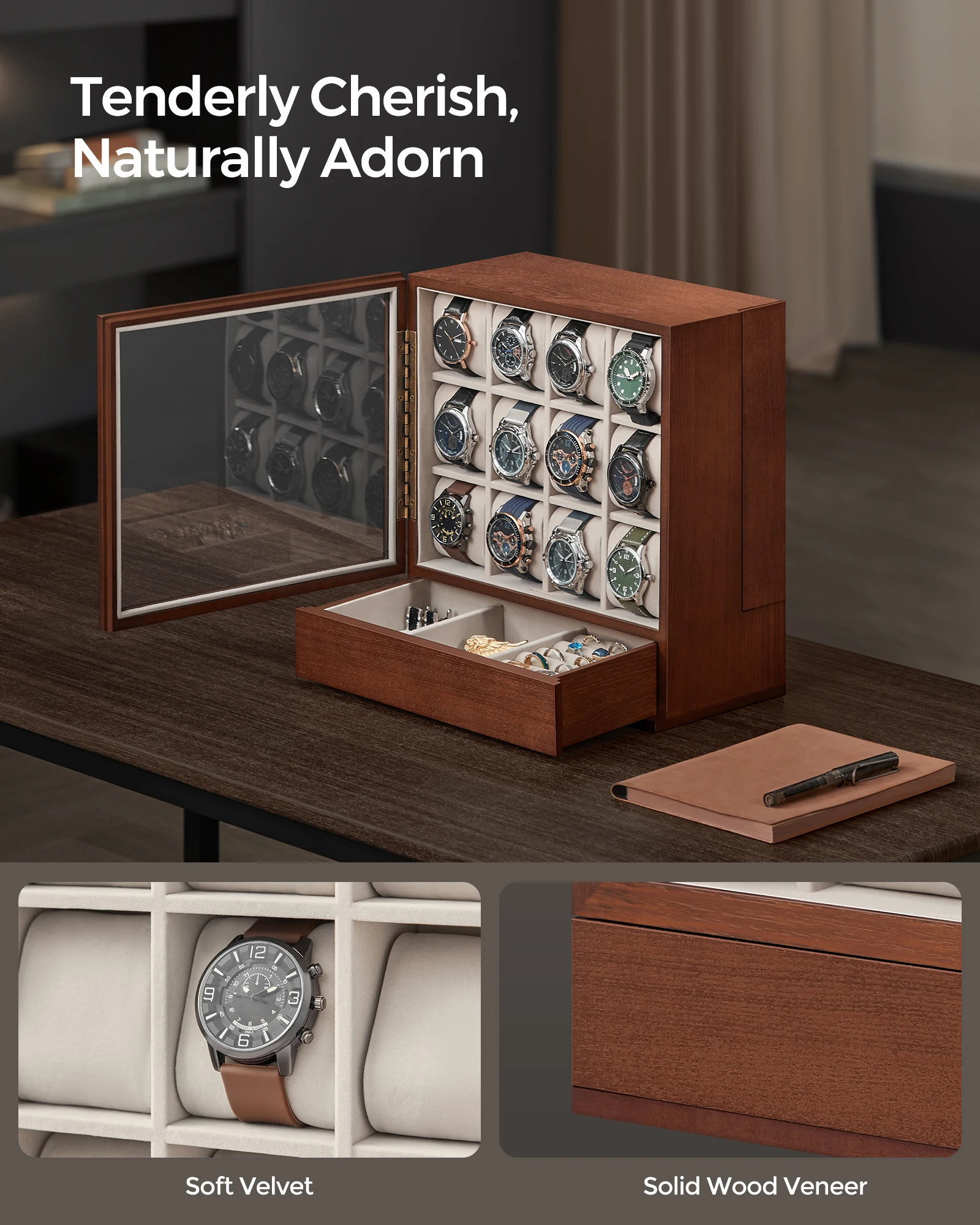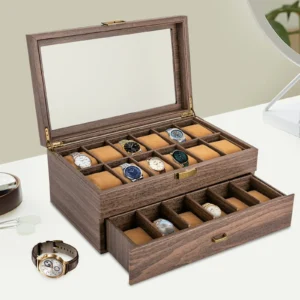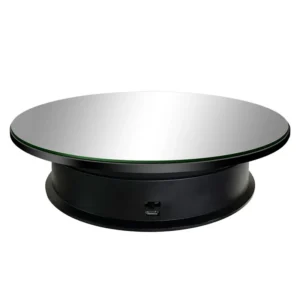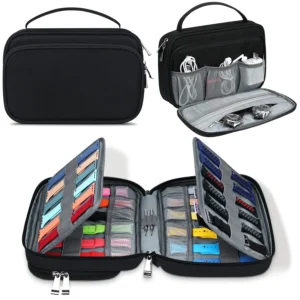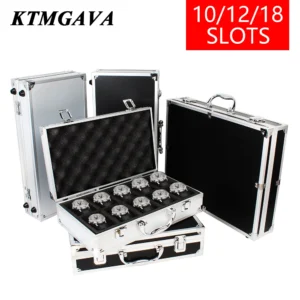Introduction: The Value of a Watch Maintenance Kit at Home
Owning a proper watch maintenance kit allows you to perform basic care for your timepieces at home, saving both time and money while preserving your valuable watches. With the right tools, tasks like changing straps, sizing bracelets, and cleaning your watches become simple DIY projects rather than expensive trips to a professional.
The financial benefits are substantial – professional services for simple tasks like strap changes typically cost between $20-30 each time, while basic cleaning services start around $50. By investing in quality tools, these frequent maintenance needs become free after your initial kit purchase. Most watch owners need to change straps or adjust bracelets 2-3 times annually, making a maintenance kit a wise investment.
Beyond cost savings, using proper tools protects your watches from potential damage. Improvised tools like kitchen knives or household screwdrivers often result in scratched cases, damaged components, or worse. A dedicated maintenance kit provides precisely engineered tools designed specifically for watch care.
In this guide, we’ll explore the essential tools every watch owner needs, explain proper maintenance procedures, and help you decide between pre-assembled kits or building your own collection. Proper watch collection storage planning complements your maintenance routine, ensuring your timepieces remain in excellent condition between servicing.
Understanding Watch Maintenance Levels: DIY vs Professional Tasks
Not all watch maintenance tasks are created equal. Understanding which jobs are appropriate for DIY care and which require professional expertise helps prevent costly mistakes and protects your timepiece investments.
Basic/DIY Tasks (Suitable for any owner):
– Strap and bracelet changes
– Basic bracelet sizing (removing/adding links)
– External cleaning and polishing
– Battery replacement for simple quartz watches
– Visual inspection and minor adjustments
Intermediate Tasks (Requiring some tools and caution):
– More complex bracelet adjustments
– Basic water resistance testing
– Minor case back servicing
– Deeper cleaning of bracelets and case exterior
– Simple crown and stem maintenance
Advanced Tasks (Best left to professionals):
– Movement servicing or repair
– Water resistance restoration
– Crystal replacement
– Dial and hand replacement
– Movement regulation and timing adjustments
Safety should always be your primary concern. Even with proper tools, forcing components or applying excessive pressure can damage delicate mechanisms. If you encounter unusual resistance or complications during maintenance, it’s best to stop and consult a professional watchmaker.
Understanding how to properly store your watches is equally important to maintenance. Considering watch box vs watch roll options can help you select the appropriate storage solution that protects timepieces when they’re not being worn or serviced.
The Essential Basic Kit: Core Tools Every Watch Owner Needs
A foundational watch maintenance kit contains several core tools that enable you to perform the most common care tasks. These essential items form the backbone of your kit and will be used frequently regardless of your collection size or watch types.
Quality matters significantly when selecting these basic tools. While budget options exist, investing in well-made tools prevents damage to your watches and ensures years of reliable service. The price difference between budget spring bar tools ($5-10) and quality options ($15-30) is minimal compared to the risk of scratching a valuable watch case.
These essential tools support basic maintenance tasks discussed earlier while providing the foundation for more advanced care as your confidence grows. Quality watch accessories complement these tools, creating a complete watch care system.
Spring Bar Tool: The Strap Changing Essential
A spring bar tool is perhaps the most frequently used item in any watch kit, designed specifically for removing and installing the small spring-loaded bars that secure watch straps and bracelets to the case.
Quality spring bar tools feature:
– Hardened steel construction that won’t bend or break
– Dual ends with different tip styles:
– Forked end for removing spring bars from most watches
– Pin end for watches with drilled lugs or harder-to-reach spring bars
– Comfortable grip to provide control during delicate operations
Proper technique is crucial to avoid scratching your watch’s lugs. Position the forked end against the spring bar shoulder (not the center), apply gentle pressure to compress the spring, then carefully slide the bar free. Quality tools typically cost between $15-40 and often feature replaceable tips for extended usability.
Precision Screwdriver Set: For Bracelets and Small Components
Watch-specific precision screwdrivers are essential for bracelet adjustments, battery changes, and various minor tasks. Unlike household screwdrivers, watchmaker’s tools feature:
- Precision-ground hollow ground tips that fit perfectly in watch screws
- Rotating caps for controlled, precise turning
- Anti-slip handles for secure grip during delicate operations
- Hardened steel construction that won’t damage screw heads
A quality set should include sizes ranging from 1.0mm to 3.0mm, covering most watch screws encountered in bracelets and case backs. Look for screwdrivers with swivel tops that allow you to apply downward pressure while turning with precision.
Quality sets range from $25-80, with premium sets offering better machining tolerances and more durable materials. The investment prevents stripped screws and damaged components, making them worth the additional cost.
Watch Loupe or Magnifier: For Detailed Inspection
A proper magnifier reveals details invisible to the naked eye, allowing you to inspect components before, during, and after maintenance procedures.
For watch maintenance, a 5x-10x magnification range provides the ideal balance between detail and working distance. Options include:
- Traditional watchmaker’s eye loupes (requiring practice to use effectively)
- Head-mounted magnifiers (leaving both hands free for work)
- Stand magnifiers with built-in lighting (best for extended sessions)
When using a loupe, position it close to your eye first, then bring the watch into focus rather than the reverse. This technique provides the clearest view and most comfortable working position.
Quality options start around $15 for basic loupes and range to $50+ for illuminated models with multiple magnification levels. The enhanced visibility makes all other maintenance tasks more precise and effective.
Microfiber Cleaning Cloths: For Safe Polishing
Specialized microfiber cloths designed for watch care remove fingerprints, dust, and light surface contamination without risking scratches to delicate surfaces.
Watch-specific cloths feature:
– Ultra-fine microfiber (higher density than standard household cloths)
– Double-sided design with different textures for various cleaning tasks
– Non-abrasive construction safe for all watch surfaces
– Washable design for repeated use
To maintain cloth effectiveness, wash them separately from other laundry using mild detergent, avoid fabric softeners, and air dry completely before storage. Replace cloths once they begin to show wear, as damaged fibers can potentially scratch delicate watch surfaces.
Many watch owners maintain separate cloths for different purposes—one for crystals, another for bracelets and cases—preventing cross-contamination of polishing compounds or oils.
Intermediate Tools: Expanding Your Kit for Deeper Maintenance
As you gain confidence with basic maintenance, expanding your toolkit allows you to tackle more complex tasks. These intermediate tools require greater care and skill but enable you to perform a wider range of maintenance procedures at home.
When selecting intermediate tools, quality becomes even more critical, as these items often apply greater force or come into contact with more delicate components. Budget case back openers, for example, can slip and cause severe case scratches or even personal injury.
As your collection grows, proper storage becomes essential. Consider a dedicated case with custom foam inserts, watchmaker’s bench organization, or specialized tool rolls to protect your investment and keep everything accessible. Proper organizing solutions for your growing toolkit helps maintain order and efficiency.
A complete intermediate kit typically costs between $100-300, depending on quality and comprehensiveness, representing significant value compared to professional service costs over time.

Watch Case Back Opener Tools
Watch cases feature various back designs requiring specific opener tools. Using the wrong tool type can damage your watch, making proper identification essential.
Common case back types and their corresponding tools include:
- Screw-down case backs: Rubber ball friction openers or adjustable case back wrenches
- Snap-off case backs: Case knife or pry-style openers
- Notched case backs: Three-prong or adjustable pin wrenches
- Rolex and similar screw cases: Specialized case back tools with precise fitment
Quality openers feature non-marring materials where they contact the watch, precise manufacturing for proper fit, and ergonomic handles that provide controlled leverage. Budget tools ($5-15) often feature softer metals that deform and slip, while quality options ($20-60) provide precision fit and durability.
Always place your watch in a proper holder before attempting case back removal to prevent slippage and potential damage. If the case back proves difficult to remove, reconsider whether this maintenance is appropriate for your skill level.
Case Holder and Movement Holder
Secure holding tools prevent watches from moving during maintenance, protecting both the timepiece and your workspace. These specialized holders secure the watch without applying pressure to delicate components.
Quality watch holders feature:
– Non-marring materials (nylon or coated metal)
– Adjustable jaws to accommodate various case sizes
– Stable bases that prevent tipping during work
– Rotating mechanisms for accessing all sides of the watch
Movement holders become necessary when a watch is disassembled, providing safe storage for the delicate mechanism while you work on the case or other components. These specialized tools typically cost $15-40 depending on material quality and adjustment capabilities.
These holders represent the difference between professional-quality maintenance and risky improvisation, preventing the common drops and slips that damage watches during home servicing.
Fine-Tipped Tweezers
Precision tweezers allow manipulation of tiny components like spring bars, bracelet pins, and gaskets without damage. Unlike household tweezers, watchmaker’s tweezers feature:
- Anti-magnetic stainless steel construction
- Precisely aligned tips with various profile options
- Fine points that access tight spaces
- Anti-static properties for working with electronic components
Quality watchmaker’s tweezers cost $15-40 per pair, with different tip styles serving various purposes. The most versatile options for home maintenance include straight-tipped and curved-tipped models with fine points.
When using tweezers, hold them like a pencil for maximum control, and practice on less valuable components before attempting delicate operations on expensive timepieces. Proper lighting and magnification make tweezers significantly more effective for precise work.
Dust Blower and Rodico Cleaning Putty
Dust and debris can interfere with watch operation and maintenance. These specialized cleaning tools remove contaminants without causing damage:
Dust blowers provide gentle air pressure to remove particles from hard-to-reach areas without the moisture or chemicals found in compressed air cans. The rubber bulb design offers precise control over air pressure and direction.
Rodico, a specialized watchmaker’s cleaning putty, lifts dust, fingerprints, and tiny debris through direct contact without leaving residue. Unlike household adhesives, Rodico is specifically formulated to be safe on all watch components and leaves no residue.
When using these tools, work in a clean, well-lit environment to prevent introducing new contaminants. The combination provides thorough cleaning capability without the risks associated with liquid cleaners or aggressive techniques.
Keeping watches properly organized in a watch collection system helps minimize dust accumulation between maintenance sessions, reducing cleaning frequency.
Specialized Bracelet Adjustment Tools
Metal watch bracelets require specific tools for safe and effective adjustment. Different bracelet designs utilize various pin systems, making versatile tools or a specialized set necessary for comprehensive maintenance capability.
Common bracelet types include:
– Pin-and-collar systems (requiring precise pin alignment during reassembly)
– Friction-fit pins (requiring controlled pressure for removal and installation)
– Screw-secured links (requiring properly sized precision screwdrivers)
– Push-button release systems (requiring minimal or specialized tools)
When working with bracelets, a proper workspace becomes especially important. Use a light-colored surface to improve visibility and prevent lost components, and always work in an area where small parts can be contained if dropped.
The specialized nature of these tools makes them particularly important when selecting between pre-assembled kits versus individual purchases, as many budget kits lack the specific tools needed for certain bracelet systems.
Bracelet Pin Removal Tools
Dedicated bracelet tools provide controlled pressure for removing pins without damaging the bracelet’s finish or bending components. These tools feature:
- Adjustable positioning systems to align perfectly with various bracelet designs
- Controlled pressure mechanisms (lever, screw, or hammer systems)
- Bracelet support to prevent bending during pin removal
- Reversible punches for different pin sizes
Universal pin tools accommodate most bracelet styles, while brand-specific tools provide perfect fit for particular watch makes. Depending on quality and versatility, these tools range from $20 for basic models to $50+ for professional-grade options.
Before removing any pins, always check for directional arrows on the bracelet indicating proper removal direction. Many bracelets have pins designed to be pushed in only one direction, and forcing them the wrong way can cause damage.
Quality watch display cases often provide the perfect flat, clean surface for bracelet adjustments while protecting other timepieces in your collection.
Jeweler’s Hammer and Pin Punches
For stubborn bracelet pins or precision reassembly, watchmaker’s hammers and pin punches provide controlled force application. Unlike household hammers, these specialized tools feature:
- Brass, nylon, or plastic striking faces that won’t damage components
- Lightweight, balanced design for precision tapping
- Comfortable handles for controlled movement
- Various head materials for different applications
Complementary pin punches come in multiple diameters to match different bracelet systems, with hardened steel tips precisely sized for common watch pins.
When using these tools, always start with gentle taps and gradually increase force only as needed. Work on a proper watchmaker’s bench or cushioned surface that absorbs impact without bouncing components.
Quality watchmaker’s hammers typically cost $15-30, with corresponding punch sets ranging from $15-40 depending on the number of sizes included and material quality.
Non-Marring Work Surface
A proper maintenance workspace protects both your watches and tools while providing organization for small components. Ideal surfaces feature:
- Soft, non-marring material that won’t scratch watch cases
- Light color for high visibility of small parts
- Defined compartments for organizing components
- Slightly raised edges to prevent parts from rolling away
Popular options include silicone watchmaker’s mats, microfiber work pads, and dedicated bench mats with component trays. Some advanced options include magnetic sections to secure ferrous tools and parts.
These surfaces provide crucial protection during all maintenance procedures and cost between $15-40 depending on size and features. The investment prevents costly scratches and lost components during routine maintenance.
Pre-Assembled Kits vs. Building Your Own Collection
Watch enthusiasts face a fundamental choice when assembling maintenance tools: purchasing a pre-assembled kit or building a custom collection piece by piece. Each approach offers distinct advantages depending on your experience level, budget, and specific needs.
| Approach | Advantages | Disadvantages |
|---|---|---|
| Pre-assembled Kit | Immediate complete solution, Often more economical, Matched components | Variable quality, May include unnecessary tools, Limited customization |
| Custom Collection | Higher average quality, Perfectly matched to your needs, Expandable over time | Higher initial investment, Requires research, Takes time to complete |
Budget kits ($20-50) typically suffer from poor manufacturing quality and material compromises, while mid-range kits ($50-120) offer acceptable quality for occasional use. Premium kits ($120-300+) generally provide professional-grade tools suitable for frequent maintenance.
A balanced approach often works best for most watch owners: start with a quality mid-range kit for essential tools, then supplement with individually selected specialty items as your needs evolve. This hybrid strategy provides immediate functionality while allowing for quality upgrades over time.
Quality watch holders provide the perfect complement to your maintenance kit, securing timepieces safely during servicing.
Essential DIY Watch Maintenance Procedures
With proper tools in hand, you can confidently perform several essential maintenance tasks that keep your watches looking and functioning their best. These procedures represent the core DIY activities appropriate for home maintenance.
For each procedure, preparation is key to success. Ensure you have:
– All required tools gathered before beginning
– Clean, well-lit workspace with organization for small parts
– Unrushed time frame without distractions
– Reference information for your specific watch model when available
Remember that patience is essential—rushing these procedures often leads to mistakes that can damage your timepiece. When in doubt about any step, research further or consult a professional rather than proceeding with uncertainty.

Changing Watch Straps and Bracelets
Changing straps refreshes your watch’s appearance and replaces worn components. This straightforward procedure requires minimal tools but benefits from careful technique.
- Place your watch on a soft work surface, dial-down for protection
- Identify the spring bar locations between the lugs
- Insert the forked end of your spring bar tool against the shoulder of the spring bar
- Apply gentle pressure to compress the spring bar while sliding it toward the center
- Once one end is free, carefully remove the entire spring bar
- Repeat for the other side of the strap/bracelet
- Clean the lug area before installing the new strap
- Insert one end of the spring bar into the new strap
- Position the strap between the lugs and use your tool to compress the exposed spring bar
- Guide the compressed end into the lug hole and verify secure attachment
For difficult spring bars or tight-fitting straps, try using the pin end of your tool through drilled lugs when available. Always pull straps away from the watch case rather than toward the crystal to prevent damage if your tool slips.
Adjusting Metal Bracelets for Perfect Fit
A properly sized bracelet improves comfort and prevents unnecessary wear. The procedure varies slightly depending on your bracelet type:
For pin-secured bracelets:
1. Identify the arrows on the inside of the bracelet (if present) indicating removal direction
2. Place the bracelet in your bracelet holder with arrows pointing downward
3. Use your pin tool to apply gentle pressure in the direction of the arrows
4. Gradually increase pressure until the pin begins to move
5. Once started, remove the pin fully with tweezers or by pushing through completely
6. Remove the appropriate number of links for proper fit
7. Reassemble the bracelet by inserting pins in the opposite direction of the arrows
8. Verify all pins are fully seated and secure
For screw-secured bracelets:
1. Identify the appropriate screwdriver size for your bracelet
2. Stabilize the bracelet in your holder
3. Turn screws counterclockwise for removal, being careful not to strip the heads
4. Remove appropriate links for proper sizing
5. Apply a tiny amount of thread-locking compound if recommended by the manufacturer
6. Reassemble and tighten screws securely without over-tightening
Always remove links symmetrically from both sides of the clasp when possible to keep the clasp centered on your wrist.
Watch Accessories, Watch Holder
$94.51 Select options This product has multiple variants. The options may be chosen on the product pageMen's Watch Organizer, Watch Display Case, Watch Organizer
Price range: $112.68 through $169.45 Select options This product has multiple variants. The options may be chosen on the product pageRotating Watch Holder, Watch Holder
Price range: $93.28 through $93.35 Select options This product has multiple variants. The options may be chosen on the product pageWatch Organizer, Watch Roll Travel Case
Price range: $88.39 through $99.36 Select options This product has multiple variants. The options may be chosen on the product page12 Watch Box, Watch Display Case, Watch Organizer
Price range: $101.20 through $141.30 Select options This product has multiple variants. The options may be chosen on the product page4 Watch Winder, Automatic Watch Winder, Watch Display Case
$391.75 Select options This product has multiple variants. The options may be chosen on the product page
Thorough Exterior Cleaning
Regular cleaning maintains your watch’s appearance and prevents buildup that can affect performance:
- Prepare a bowl of lukewarm water with mild soap (only for water-resistant watches)
- Use a soft toothbrush to gently clean bracelet links, case crevices, and the clasp
- Rinse thoroughly with clean water if using soap
- Dry completely with a lint-free cloth
- Use your microfiber cloth for final polishing of all surfaces
- Apply a watch-specific polishing cloth to restore shine to polished surfaces
- Use Rodico putty to remove any remaining debris from hard-to-reach areas
- Finish with a dust blower to remove any loose particles
For leather straps, avoid water entirely—use a barely damp cloth followed by thorough drying, then apply appropriate leather conditioner. Always consider specific material requirements, especially for vintage watches or special finishes.
Proper leather watch box maintenance complements your watch cleaning routine, ensuring both timepieces and their storage remain in excellent condition.
Quartz Battery Replacement
Replacing a quartz watch battery extends its life for several more years:
- Identify your battery type using the case back information or by checking the old battery
- Place the watch on your work surface, case back facing up
- Open the case back using the appropriate opener tool
- Document the position of any parts you remove to ensure proper reassembly
- Locate the battery and note its orientation (+ side up or down)
- Use plastic tweezers to carefully remove the old battery
- Clean contact surfaces gently if necessary
- Insert the new battery in exactly the same orientation
- Test function before closing the case
- Ensure the gasket is clean, undamaged, and properly seated
- Close and secure the case back, being careful not to overtighten
Always handle batteries with non-metallic tweezers to avoid short circuits, and properly recycle old batteries according to local regulations. Be aware that water resistance may require professional testing after opening the case.
Best Practices for General Watch Care
Beyond specific maintenance procedures, these general practices help preserve your timepieces:
- Wind automatic watches occasionally if not worn regularly
- Keep watches away from strong magnetic fields
- Avoid exposing watches to extreme temperatures or rapid temperature changes
- Store watches in a controlled environment with moderate humidity
- Rotate through your collection to distribute wear and maintain movement lubrication
- Have water resistance professionally tested annually for dive watches
- Remove watches before activities involving heavy impact or vibration
- Clean watches after exposure to salt water, chlorine, or excessive perspiration
Consider the environment where you store your collection. Humidity below 60% prevents corrosion while avoiding excessive dryness that can affect gaskets and leather components. Temperature stability between 65-75°F (18-24°C) provides ideal conditions for both mechanical movements and batteries.
Quality storage solutions for watch collections protect your timepieces between wearing and during maintenance periods, preserving their condition and value.
Important Safety Considerations for DIY Watch Work
Safety precautions protect both you and your watches during maintenance activities:
- Work in a clean, well-lit area with minimal distractions
- Use a parts tray or magnetic surface to prevent losing small components
- Apply only gentle pressure—if significant force seems necessary, stop and reassess
- Keep a record of disassembly steps for complex procedures
- Work over a soft surface to minimize damage if parts are dropped
- Keep chemicals, solvents, and lubricants away from watch movements unless specifically trained
- Ensure proper eye protection when working with spring-loaded components
- Maintain clean hands free from lotions or oils that can transfer to components
Know your limitations—certain warning signs indicate a task exceeds DIY capabilities:
– Unusual resistance during disassembly
– Visible damage to gaskets or seals
– Water or condensation inside the case
– Irregular ticking or complete stoppage after maintenance
– Parts that don’t reassemble correctly
When these signs appear, seeking professional service prevents further damage to valuable timepieces.
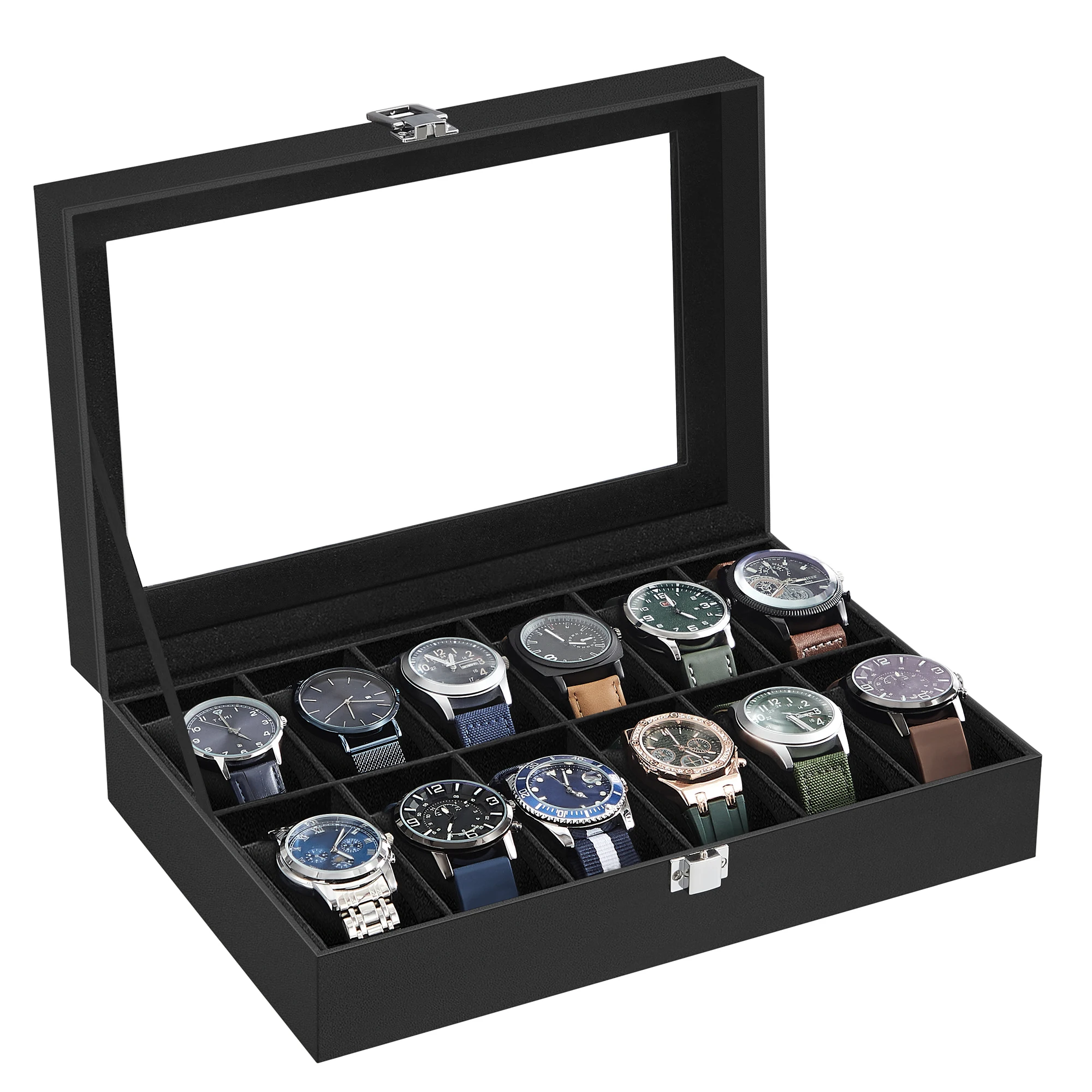
Frequently Asked Questions About Watch Maintenance Kits
What’s the minimum investment for a useful watch maintenance kit?
A quality basic kit with essential tools starts around $50-75. Budget options exist but typically sacrifice quality and durability. For occasional use on modestly priced watches, a mid-range kit provides the best value.
How often should I service my watches at home?
External cleaning can be performed monthly, while strap changes and bracelet adjustments are typically needed 2-3 times annually. Battery replacements for quartz watches are generally required every 1-3 years depending on the model.
Can I use the same tools for vintage and modern watches?
While many tools work universally, vintage watches often require specialized tools for unique case designs and delicate components. Consider supplementing your kit with period-specific tools if you maintain vintage timepieces.
How do I know if my maintenance kit tools are good quality?
Quality tools feature precise machining, hardened steel components, comfortable ergonomic handles, and smooth mechanical operation. Reputable brands typically provide warranties and replacement parts for their tools.
Should I attempt to open all types of watch cases?
No. Certain watches, particularly high-end luxury models and dive watches with complex sealing systems, should only be opened by trained professionals. When in doubt, consult the manufacturer’s recommendations.
The Long-Term Benefits of Proper Watch Maintenance Tools
Investing in quality maintenance tools provides benefits extending far beyond immediate cost savings. A well-equipped kit allows you to:
- Extend the lifespan of your watches through regular care
- Adjust watches for optimal comfort without waiting for service appointments
- Customize your collection with easy strap changes
- Develop a deeper appreciation for watchmaking craftsmanship
- Build confidence and skills applicable to more advanced watch enthusiasm
The financial advantage becomes clear when considering lifetime ownership costs. A quality maintenance kit costing $150-200 typically pays for itself after just 5-10 DIY procedures that would otherwise require professional service. For a collection of even modest size, this represents thousands in potential savings over the years.
Beyond economics, there’s significant satisfaction in caring for your own timepieces. The knowledge and skills gained through maintenance deepens your connection to these mechanical marvels and enhances the overall ownership experience.
By combining proper tools with respect for their limitations, you strike the perfect balance between DIY maintenance and professional service, ensuring your watches receive appropriate care throughout their lifetime.

